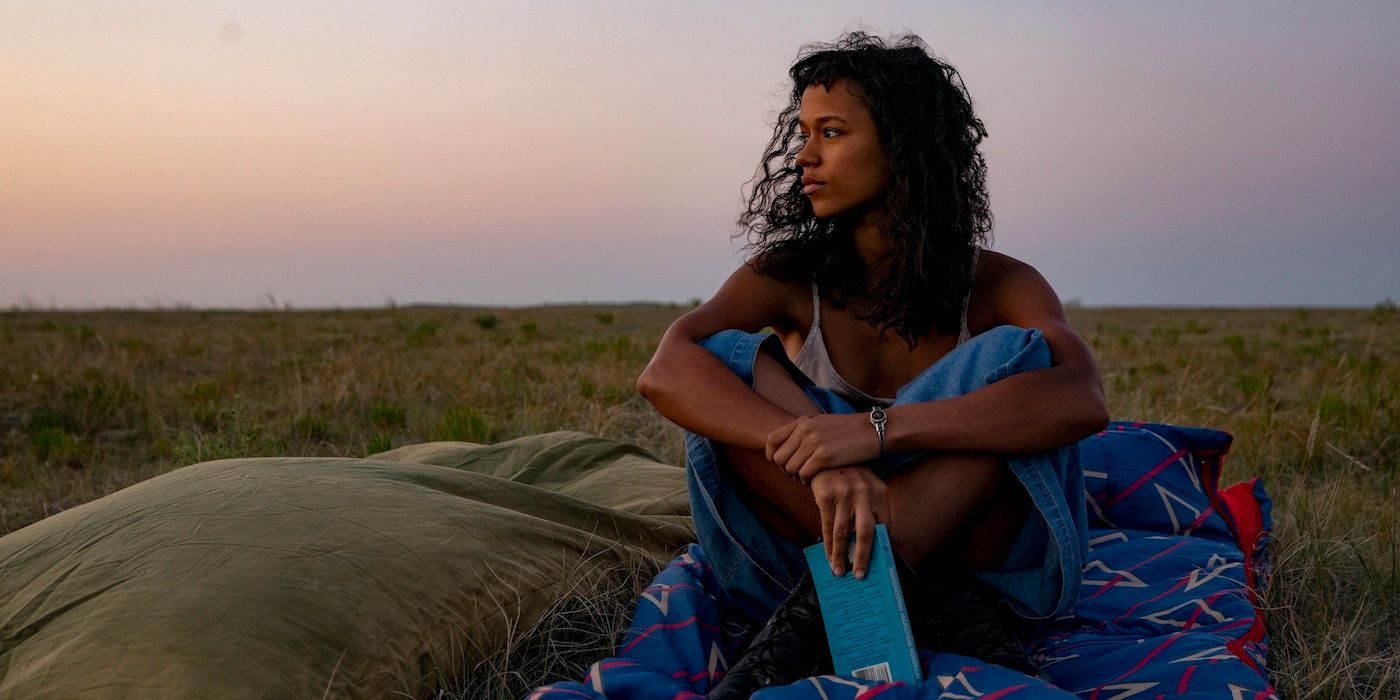Cannibalism remains one of the last taboos, a subject that will always stimulate horror and revulsion in audiences. It has often acted as a means through which filmmakers can explore issues of political, social and economic disparities. Often used for shock value in the video nasties of the 1970s and 1980s, it has also been a means by which the complex inner workings of the human psyche can be explored. This is particularly true for films that center on women protagonists.The recent release of Bones and All (2022) has reignited interest in the female cannibal, but it is by no means the only example. Alongside Bones and All, there are other notable examples of women cannibals that explore how flesh eating is used as an outlet for loneliness, desire and sexuality, namely Der Fan (1982), and Raw (2016).
In Der Fan, Simone (Désirée Nosbusch) is obsessed with a new-wave pop performer known as R, spending her days waiting hopefully for a letter. A chance meeting leads to a sexual encounter between Simone and R but when he rejects her, she reacts violently. In Raw, lifelong vegetarian Justine (Garance Marillier) takes her place in veterinary school. As part of a period of brutal hazing, she is forced to eat meat. This unleashes a primal hunger in her that must be satisfied at any cost. In Bones and All, Maren (Taylor Russell) lives a nomadic lifestyle with her father, moving every time she takes a chunk out of someone. After he abandons her, she takes to the open road, eventually meeting others who share her condition.
An Insatiable Hunger
All three protagonists are united by an ache that cannot be filled. One the surface, this ache seems physical, a hunger for human flesh. But a deeper look at the lives of these characters highlights that, underneath this appetite, lies a craving for connection and acceptance. All three protagonists are dealing with intense loneliness and isolation. By the very nature of their behavior, Simone's singular obsession, and Justine and Maren's physical cravings, they are outcast from society.
This loneliness is palpable throughout the films, in Maren's sad eyes as she watches the world whip by from a bus, and in Simone's dejected departure from the post office each day. Simone has become a shell, internalizing her vivid, romance soaked daydreams of R to the point that nothing else exists. Reviews of the film position this dynamic as one of idolatry and dictatorship, but it is also possible to read Simone as the one in charge of this dynamic. Although she has defined herself by her obsession with R, we see that when he disappoints her, and disrupts the fantasy, she reacts with violence. Through her cannibalism she achieves her ultimate goal, of possessing the object of her desire forever and in totality.
For Justine and Maren, this goal is more physical, to quench their growing hunger. But both are actively seeking connection from those around them, with Justine trying to fit in with peers and her sister, and Maren finding a ragtag community of fellow cannibals. Her fateful meeting with Lee (Timothée Chalamet) provides her with the connection she so craves, and an opportunity to be seen and understood for who she really is.
Sex and Death
It is impossible to separate the intertwining vines of sexuality and cannibalism in these films. This idea of total possession, and of love transgressing the physical is present in all three narratives. This sexual connection is also emphasized in the ways the film presents these women. We see Simone sensually licking an electric carving knife as she ritualistically dismembers R. Justine loses herself in an animalistic sexual encounter with Adrien, biting chunks out of her own arm at the point of orgasm. Maren lets herself go during an erotically charged encounter with a classmate, one that ends with her fleeing through the night with blood running down her chin. The sensuality and pleasure of eating is morphed into something more stomach churning, as we see all three women give themselves over, quite literally, to the pleasures of the flesh.
But we are also confronted with the romance of these women's relationship with meat. This is particularly true in Maren's relationship with Lee. When faced with losing him, she fulfills his final request, committing the ultimate act of consumption, engaging in the titular 'bones and all' act of consuming a person in their entirety. This is positioned by other cannibals she has encountered as a personal act of almost spiritual transcendence, the ultimate act of the cannibal. But for Maren, this personal act becomes one of communion between herself and her lover in his final moments, and, much like Simone, becomes a way to keep Lee with her, to absorb him into her own body. It is a moment of tenderness, and profound devotion, that again subverts the brutality of cannibalism, allowing the viewer to see it as part of a deeper connection.
Self Discovery Through Transgression
The spirituality of this transgressive act is also explored in each of the three films. For each of these women, the act of cannibalism forms part of a larger journey of self-discovery, and a process of self-acceptance. Simone's consumption of R allows her to work through her obsession, to remove the source of her distraction, and emerge on the other side of the confusing period between childhood and adulthood. Her act of communion releases her from her fixation, whilst still providing the ultimate physical representation of her devotion. Her shaved head can be seen as either penance or rebirth, depending on your perspective. That she has made herself so visibly 'other' acts as a means of telling the world that she has transformed.
This journey to acceptance is evident in Maren's story, as well as Justine's. Theirs is a slightly different narrative, as Simone's act appears to be a one-off event, driven by her devotion to R, but Justine and Maren are driven by physical impulses that require them to consume flesh. For Justine, this has been a dormant urge that is awakened during a time of personal change and a shift towards independence. Her relationship with her sister Alexia (Ella Rumpf) is equal parts co-dependence and frustration, as Justine tries to carve out a life for herself outside of her family shadow. Justine's story ends with a return to this family unit but as a changed, more independent person, and her cannibalism acts as a metaphor for the transition from family to independence.
For Maren, her self-acceptance must come from within. She has been abandoned by her family, in a cruel final act that punishes her for the sins of her parents. When faced with the reality that she is alone in the world, she demonstrates a capacity for self-reliance that speaks to her strength of character. She is forced to grow up, to be independent and to figure out how to manage her appetite alongside a facsimile of a normal life. We see throughout the film that she is wily, and capable of looking after herself, but still feels compelled to find her place within a family dynamic. Her encounter with her mother, by turns horrifying and heartbreaking in equal measure, acts as the final severing of childhood and her resolve to make her own life speaks to her inner strength.
All three characters are wholly relatable, making the horror of their appetites even greater. There is something freeing, as a woman watching these films, about seeing them abandon restraint and give in to their animal side. The struggles of their daily lives come, not from a desire to fit in, but a confusion about why they should want to. Simone sees daily life as a boring, grinding chore, and so instead finds freedom in her daydreams. Justine takes part in the hazing rituals of her college, but looks at her classmates through blank eyes, unsure as to why she should want to be a part of the group. Maren is a quiet observer, noting the lives and habits of both cannibals and non-cannibals with equally remote interest. The rituals of daily life for both groups hold a fascination for her, but over the course of the film she makes it clear that she will not belong to either side, instead choosing to exist somewhere in-between with her own rules and moral code.
Primal Disgust Made Flesh
Without heading too far into academic theory, it is easy to see how the woman as cannibal trope plays into the idea of the monstrous feminine. Women as monsters has always been a mine of creative inspiration in horror, and has allowed stories to explore the ways in which women exist in society. Cannibalism has often been a means through which filmmakers can shock audiences, by tapping into our primal fear and disgust. When women are portrayed as cannibals, this disgust is two-fold. The cultural consumption of women's bodies, through gender based violence, capitalism and objectification means that women are positioned as the eaten rather than the eater. The female cannibal, with her associated violence and ability to transgress these cultural and moral boundaries disrupts this system. Thus, she is doubly vile, for not only does she transgress the moral boundary of not eating one's own kind, but also violates the limits that society places on women. For these three women, the transgressive nature of their cannibalism allows them to also transgress these wider social barriers that center women as consumable rather than as consumers. They are violent, capable of killing and have no qualms about taking a bite out of you. In a society where women are positioned as prey, these predators are a welcome addition to the food chain.





